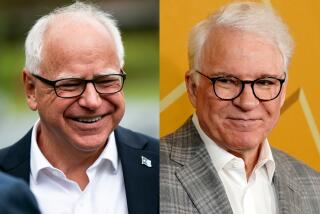Preston Martin, 83; vocal former Fed vice chairman and S&L; regulator
- Share via
Preston Martin, an economist and financial regulator who served as the outspoken vice chairman of the Federal Reserve in the mid-1980s and later took part in private efforts to revive troubled savings and loans, has died. He was 83.
Martin, a Los Angeles native, died peacefully Wednesday at his home in San Francisco after a brief battle with cancer, daughter-in-law Margaret Lowrie Robertson said Thursday.
For the record:
12:00 a.m. June 2, 2007 For The Record
Los Angeles Times Saturday June 02, 2007 Home Edition Main News Part A Page 2 National Desk 1 inches; 27 words Type of Material: Correction
Martin obituary: An obituary of Preston Martin, former Federal Reserve vice chairman, in Friday’s California section identified Margaret Lowrie Robertson as Martin’s daughter-in-law. She is his stepdaughter.
As the top S&L; regulator for California and then the nation in the late 1960s and early 1970s, Martin foresaw the looming problems that would later cripple the thrifts, advocating adjustable-rate mortgages and a secondary market for buying loans to diminish the risk of the business, said William J. Popejoy, a banking executive ally.
Adjustable-rate mortgages didn’t become widely available until after the collapse of the S&L; industry in the 1980s; earlier, Martin had overseen the creation in 1970 of the Federal Home Mortgage Corp., or Freddie Mac, which buys loans and packages them into securities for sale to investors.
“Freddie Mac was his baby,” said Popejoy, who joined Freddie Mac shortly after its founding and whom Martin promoted to be its president and chief executive less than two years later.
The affable Martin was “irrepressible” in arguing his positions, Popejoy added: “Sometimes people would sort of get blown back by him, because he was almost evangelical about the things he believed in.”
As a teenager, Martin delivered newspapers in the Hollywood Hills after his father died, then paid his way through USC by grading papers and working the graveyard shift at a Lockheed plant, said his wife, Genevieve Martin. After Army service, he earned a doctorate in monetary economics at Indiana University before returning to USC, where he taught finance and economics to graduate students for 15 years.
But he was inclined to business as well as academia, starting a mortgage company and a real-estate development firm, and consulting for S&Ls.; Publicly berating the thrift industry for its stodginess in the latter role, he caught the attention of then-California Gov. Ronald Reagan, who appointed him commissioner of S&Ls; for the state in 1967.
Two years later, President Nixon named Martin chairman of the national S&L; regulator, the Federal Home Loan Bank Board, which under Martin liberalized the rules for thrifts, allowing them to issue long-term certificates of deposit as well as passbook accounts and to write consumer loans in addition to mortgages.
He plunged back into private business in 1972, founding PMI Mortgage Insurance, which he sold to Allstate Insurance, then part of Sears, Roebuck & Co. He stayed on to manage PMI and later became head of Sears’ financial services group but became frustrated with the corporate bureaucracy and eager to return to public service, his wife said.
The opportunity came in 1982, when Reagan, then president, named him Fed vice chairman. Violating unwritten rules of deference at the central bank, Martin spoke openly about his differences with then-Chairman Paul Volcker, causing Fortune magazine to headline one story: “The Man Who Would Be Volcker.”
When reporters read Martin’s comments on the international debt crisis to Volcker, the Fed chairman shot back, calling them “incomprehensible” as reported. Martin resigned from the Fed in 1986 at the end of his four-year term as vice chairman amid reports that he had sought the chairmanship himself; instead, Alan Greenspan would be appointed.
In the attempt to breathe life into failing thrifts and banks, Martin joined a partnership headed by former U.S. Treasury Secretary William Simon, which took control of failing institutions with the help of the federal government. The group succeeded in turning around two Hawaii-based institutions but was unsuccessful in saving several Southland S&Ls;, notably Western Federal Savings & Loan and Southern California Savings.
In recent years, Martin devoted time to nonprofit work on inner-city housing and financial education issues, wrote a book, “The Complete Idiot’s Guide to the Federal Reserve,” and was a frequent commentator on economic issues for television and radio networks.
“He was a bit of a ham, and he liked being on TV,” his wife said.
In addition to his wife and daughter-in-law, Martin is survived by a son, Pier, of Las Vegas, two granddaughters, Audrey and Emily; three stepdaughters; and five step-grandchildren.
More to Read
Inside the business of entertainment
The Wide Shot brings you news, analysis and insights on everything from streaming wars to production — and what it all means for the future.
You may occasionally receive promotional content from the Los Angeles Times.











